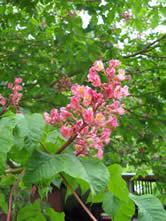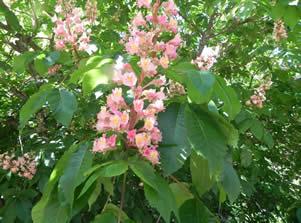Latin name: Aesculus x carnea (A. hippocastaneum x A. pavia)
by Vancouver Island Master Gardeners Association
In a garden as large as Milner Gardens, horse chestnuts have room to be feature trees as they can grown to 20 m or more and have a spreading canopy. The red horse chestnut flowers in May-June. In most years, the entire tree is covered with red, yellow/white-centered blossoms arranged in candle-shaped clusters (panicles) which attract swallow-tail butterflies. In summer, the large canopy is dark-green, making a pleasant shade tree. In fall, there are fruit which have a spiny greenish-brown exterior shell, housing 1-2 shiny brown chestnuts (conkers). The conkers are favorites of deer, squirrels, and children, but care should be taken not to eat these attractive fruit, because they are likely to cause mild stomach upset. In winter the tree shows its intriguingly regular skeleton.



Photos courtesy of: Dorothee Kieser
|
Attribute |
Description |
|---|---|
|
Form: |
Rounded decidous tree |
|
Foliage: |
5 to 7 palmate leaves, leaflets are 25 cm (8-12") long and ovoid in shape on short stalks. |
|
Height/Width: |
Height up to 20 m (70 ft) |
|
Hardiness Zone: |
5b |
|
Exposure: |
Sun or partial shade |
|
Flower colour: |
Pale red to red with yellow centers |
|
Leaf colour: |
Mid to dark green |
|
Flower time: |
May-June |
|
Preferred soil and Watering: |
Well-drained, but moist, deep fertile soil |
|
Other: |
In contrast to the edible chestnut (Castanea sativa), the horse chestnuts and all other parts of the tree are not edible, causing a mild stomach upset if ingested. |

